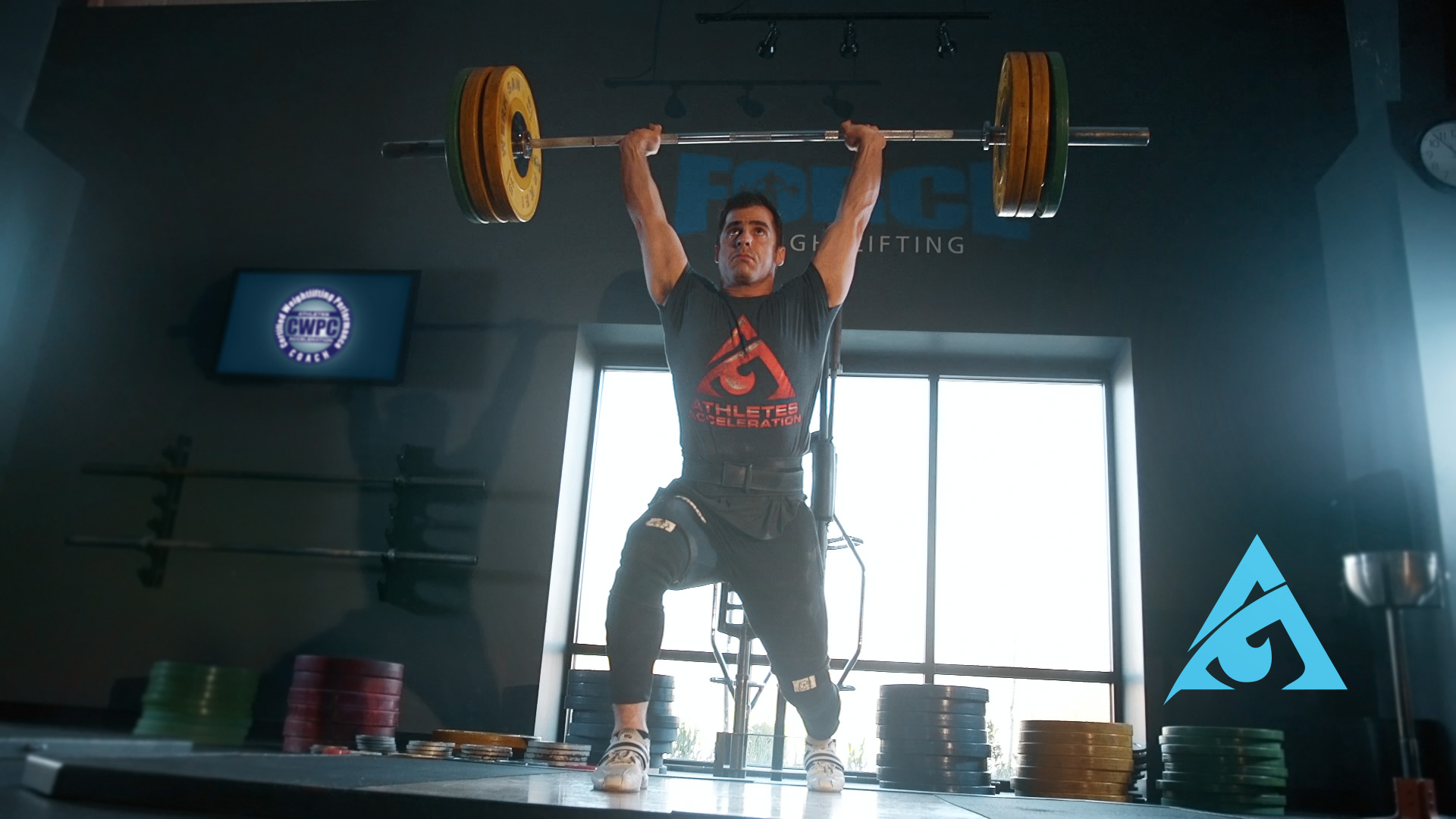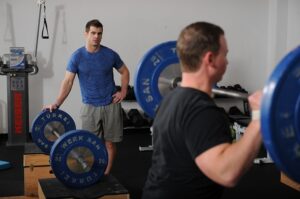
How to Determine If An Athlete Should Olympic Lift
Today’s guest post comes from Wil Fleming, who just released his excellent Certified Weightlifting Performance Coach course, which is currently being offered at an introductory for $100 off discount.
Eight years ago, when I first opened my business, if you had asked me “Which athletes should Olympic lift?”, I would have answered:
“Anyone with a pulse.”
While my vigor and passion for the Olympic lifts as a training tool have only grown, my group of athletes that immediately begin weightlifting movements has grown smaller. I still believe that most athletes can benefit greatly from the Olympic lifts, and have seen it happen hundred and hundreds of times, but I have developed a system and an eye for who should be weightlifting.

Below are the four considerations that I go through with my athletes to determine who is ready to do the Olympic weightlifting movements.
1. Assess
The first and simplest step in determining if an athlete should Olympic lift is to assess their movement ability prior to starting. As any competent trainer/coach knows that assessment prior to training is important no matter the goal.
There are plenty of different tools for assessment based on your background, and needs as a coach. Similarly, with athletes looking to Olympic lift, I want to see a variety of screens passed before I say “let’s go do some cleans.”
We have several screens or assessment tests that we use to determine if an athlete can A) Olympic lift B) do it well.
The one that coaches are most familiar with would be the FMS active straight leg raise test. This is a gross simplification of the test and the desired outcome, but the athlete starts in supine and lifts one leg as high as they can go. We want to see a score of 2 or 3, in FMS terms, to green light the athlete for hinging into hang Olympic weightlifting movements.

So why exactly are we concerned about the FMS score for an ASLR?
First off, hinging is a vital component to an athlete’s ability to perform an Olympic lift or any derivative. In setting up on the back, the athlete has nearly all variables taken out of the hip flexion, or hip hinge equation. This position is the simplest form of hip flexion we can achieve and if an athlete is unable to score a 2 or 3, it would be pretty poor judgment to believe that they can get in a good hinging position while loaded with a barbell and additional weight. Could I absolutely get them in a good position with lots of coaching? Probably, but I would not risk the potential for compensatory patterns popping up.
No, 2 or 3? It’s cool. We can develop better hip flexion through a variety of correctives and get the athlete Olympic lifting if they have numbers 2-4 down.
2. Pre-Requisites
Going into high school, you weren’t thrust right into calculus or rocket science class (is that a class?). No, instead you got your basics in multiplication and algebra, or chemistry and physics.
Similarly, weightlifting movements are pretty advanced to perform. Now, I’m not going to compare them to calculus or rocket science, but there’s more going on than in the dumbbell curl.
Pre-requisites, at the very least, allow you to speak the same language. When coaching the Olympic lifts, it is extremely helpful to be able to refer to other movements to which the athlete is somewhat familiar. “Jump,” “squat,” and “hinge” all work a lot better when the athlete knows to what you are referring.
In this case, we need some pre-requisites to Olympic lifting. Fortunately, they aren’t as difficult as chemistry was.
First is the ability to squat. I’m not referring to a particular amount of weight, but just the capacity to do a pretty good looking squat and maintain balance across the foot for the entire movement. Ideally, we have exposed them to a front squat of some sort. This is going to allow the athlete to receive the barbell in the clean or snatch.
I teach all my athletes the hang power clean first. While I am not looking for an athlete to squat all the way under to receive it, I do want to see them understand how to retreat the hips when accepting load.
Next up is hinging. The athlete should be able to do a good looking RDL with a kettlebell or barbell. I want to see an athlete understand balance (again), unlocked knees, and hips going backwards. If we don’t prepare an athlete with the ability to hinge, we end up with athletes that clean by jumping a foot forward. Set them up for success by teaching the hinge first.
Lastly, we need some knowledge of plyometrics. The athlete should be able to jump and land. We are primarily concerned with jumping from a hip width stance (the same one we use for pulling in the clean or snatch) and landing in a shoulder width stance (the same one we want when receiving the bar).

If all three of these things are knocked out, then an athlete is ready to learn the Olympic lifts.
3. Athlete Needs
In its most basic sense, we look at the energy system demands and strength/power demands of the sport in which the athlete is competing. From that information, we must determine whether the athlete would benefit from adding Olympic lifts to that equation.
Olympic lifts fall on a particular portion of the force velocity curve that mean they maximize power output. Generally this number is around 60-80% of max force, exactly where heavy Olympic lifts tend to rest. In other words, getting an athlete proficient in the Olympic lifts will help the athlete develop a much higher power output, resulting in improved testing measures (vertical jump, broad jump, 10 yd sprint time), and improved on court/field performance.
If the athlete competes in a sport that values those attributes – which is effectively almost every sport – then you have passed the next step to determine whether an athlete should Olympic lift.
4. Sport Demands
Determining the demands of the sport will be the final hurdle. Specifically, what are common movements in the sport, and would using the Olympic lifts unnecessarily add to the trauma that the sport causes?
Being that you are on Eric Cressey’s website I can imagine it would be heresy to say that baseball players SHOULD snatch, and don’t worry: I’m not going to. If that’s where your brain took you, then we are on the same page.
We look at two things when it comes to sport demands. The first is the actual sport, and then we look at the athlete’s level/training age.
To take the baseball player for example, the snatch will typically be eliminated. This is not because of inherent danger, but rather that some of the more extreme ranges of motion in the snatch may create issues in a population with a combination of structural changes and accumulated fatigue that could lead to problems. Similarly, for our population of swimmers we don’t snatch due to the accumulated fatigue most swimming strokes cause.
That said, the clean doesn’t have the same level of incidence of shoulder issues that the snatch does (see this study), so in the eyes of many, the criteria for baseball or swimming would be passed.
Our next set of questions arises when we look at the age or experience level of the athlete. When we have had pro baseball players in the gym, and particularly under a limited time frame, we often choose to not use the clean in their training. Many times these athletes have no experience with the clean, but have trained for a number of years; at this point we are introducing a completely new skill to an already highly skilled athlete.
Will there be power production improvements? Most likely.
Will that mean they are better professional baseball players? Probably not.
The case of the high school baseball player is much different. I likely have a lot more time (years, potentially) with them. Their training age is fairly young, they’re often multi-sport athletes, and the benefits of increased power production are incredible.
Conclusion
Once these four hurdles are cleared, an athlete is likely ready and able to Olympic lift. That doesn’t mean you are ready to start them on that path. You have to have a repeatable and simple method for teaching the lifts to your athletes, and you have to have a method for identifying and correcting mistakes early and often. If you don’t,then I would highly suggest you don’t worry about teaching the lifts; it’s probably not worth it for your or your athletes’ time.
If you do or don’t, but want to learn my system for teaching thousands of athletes how to use weightlifting movements to become better athletes, please consider checking out my new resource, the Certified Weightlifting Performance Coach course.
Note from EC: I’ve gone through Wil’s course myself; it’s very thorough and a continuing education option I’d highly recommend, especially with it being on sale through October 7. You can learn more HERE.



